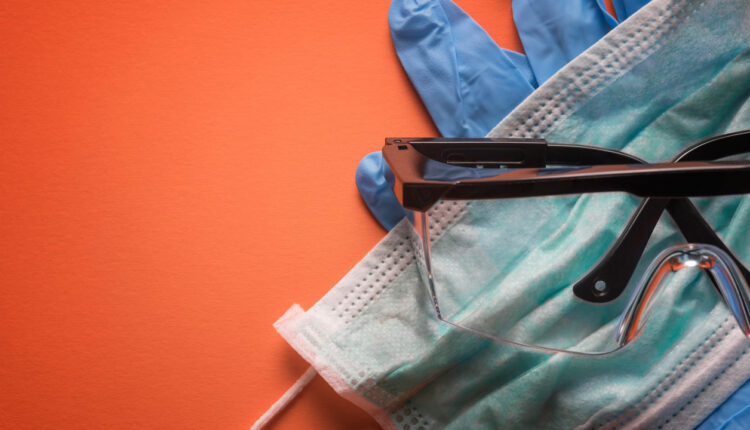 natasaadzic / iStock / Getty Images Plus
natasaadzic / iStock / Getty Images Plus
How to Practice Emergency Dental Care Safely
| Esther Ordonez Fernandez, DDS; Claire Sayoc, DMD; and Geraldine Weinstein, DDS—members of the dental community at the University of Connecticut School of Dental Medicine in Farmington—are blogging for Decisions in Dentistry about COVID-19. |
Dental procedures produce aerosols that carry microorganisms, which can contaminate surrounding areas. During the COVID-19 pandemic, most elective dental procedures have been postponed, decreasing the risk of viral spread.1 As patients with COVID-19 have high viral loads in the oropharyngeal area early on in the disease process, extreme precaution must be taken during emergency dental procedures to minimize spread of the virus.2 Avoiding the use of high-speed drills and air water syringes decrease the likelihood of aerosolizing viral particles. Patients treated for emergency dental problems must be asymptomatic of respiratory illness and afebrile, with no known exposure to individuals with COVID-19. How the COVID-19 virus spreads—even in asymptomatic patients—is uncertain, so proper personal protective equipment (PPE) is essential.1 Following is a guideline for correct use of PPE during emergency dental treatment.3 The guideline also outlines conservation of PPE to address current shortages.
Prior to greeting a patient for treatment, you should wear PPE to decrease risk of transmission of viral particles.
Prior to seeing a patient, wash your hands thoroughly and, in this order, place gown, eye protection, mask, and faceshield followed by gloves. Ask the patient to rinse with hydrogen peroxide prior to beginning treatment.
Gowns
- Always use a gown when seeing a patient.
- Do not touch your gown with your dirty gloves.
- Gowns should be removed and placed in a receptacle nearest to your procedure room.
Eye Protection
Eye protection is essential to protect the eyes from salivary droplets containing the virus. The ocular mucosa is an effective pathway for viral transmission.4 Eye protection should be removed and reprocessed if it becomes visibly soiled or difficult to see through. Ideally, you will wear both protective glasses and a faceshield mask.
- Eye protection, such as faceshields, should be discarded when it cannot be fastened securely, or visibility is an issue even after reprocessing.
- Do not touch your eye protection. If you touch or adjust your eye protection, you must immediately perform hand hygiene and reprocess the eye protection.
- You should leave patient care area if you need to remove your eye protection after a dental procedure to decrease risk of exposure to aerosolized virus particles.
Facemasks
The transmission of COVID-19 happens mainly through aspiration of droplets that are exhaled after talking, coughing, or sneezing, and by direct contact with the secretions of an infected person.5 Proper use of a facemask sealed over the nose and mouth is essential.
- The facemask should be removed and discarded if soiled or damaged. Otherwise consider reuse with other patients.
- Do not touch your facemask once gloved, otherwise the mask should be considered contaminated.
- Not all facemasks can be re-used. Once a facemask cannot be secured to your face due to tearing or loss of elastic ear hooks, it must be discarded.
- Leave the patient care area if you need to remove the facemask. Facemasks should be carefully folded so that the outer surface is held inward and against itself to reduce contact with the outer surface during storage. The folded mask can be stored between uses in a clean sealable paper bag or breathable container.
- N95 masks or greater provide protection from the novel coronavirus. When N95 masks are used, you should wear a regular mask over it to keep the N95 from being contaminated, allowing for reuse. N95 masks should be stored in a paper bag and secured when not in use.
Gloves
- Clean or dirty, DO NOT touch anything but a patient and instruments with a gloved hand.
- DO NOT leave the operatory with gloved hands.
- Ask an assistant get you anything you may need once you are gloved.
- The gloves are the first to be removed when you finish with a patient.
Hydrogen Peroxide Rinse Protocol
Advise your patient that per American Dental Association recommendation, use of a hydrogen peroxide rinse will be required prior to treatment to decrease viral and bacterial load of the patient. This decreases the risk of spread for the providers. In addition, if a procedure like an extraction is done, the likeliness for infection is decreased as well.
- Fill a small disposable cup with 50:50 mix of 3% hydrogen peroxide and water. This creates a 1.5% solution of hydrogen peroxide, which has been shown to be effective against viruses.
- Ask the patient to take a mouthful and hold it in his or her mouth for 30 seconds.
- Give the patient the saliva ejector to remove liquid from mouth and repeat the rinse one more time, again holding for 30 seconds.
Conclusion
After seeing a patient, remove gloves, wash or use hand sanitizer, if gown is contaminated, remove first, wash hands again, and then remove faceshield or goggles. If faceshield or goggles are contaminated, wash hands again prior to handling your mask. This is especially true if you are using an N95, which you should not contaminate to allow for reuse.
References
- American Dental Association Accessed 4/1/2020: https://www.ada.org/en/publications/ada-news/2020-archive/march/ada-adds-frequently-asked-questions-from-dentists-to-coronavirus-resources
- Centers for Disease Control Accessed 4/1/2020 : https://www.cdc.gov/coronavirus/2019-ncov/hcp/ppe-strategy/eye-protection.html
- Chan JF, Yuan S, Kok KH, To KK, et al. A familial cluster of pneumonia associated with the 2019 novel coronavirus indicating person-to-person transmission: A study of a family cluster. Lancet. 2020;395(10223):514-23. doi:10.1016/S0140-6736(20)30154-9.
- Lu CW, Liu XF, Jia ZF. 2019-nCoV transmission through the ocular surface must not be ignored. Lancet. 2020;395(10224):e39. doi:10.1016/S0140-6736(20)30313-5.
- Sabino-Silva R, Jardim ACG, Siqueira WL. Coronavirus COVID-19 Impacts to Dentistry and potential salivary diagnosis. Clin Oral Investig. 2020 Feb 20. doi:10.1007/s00784-020-03248-x.


